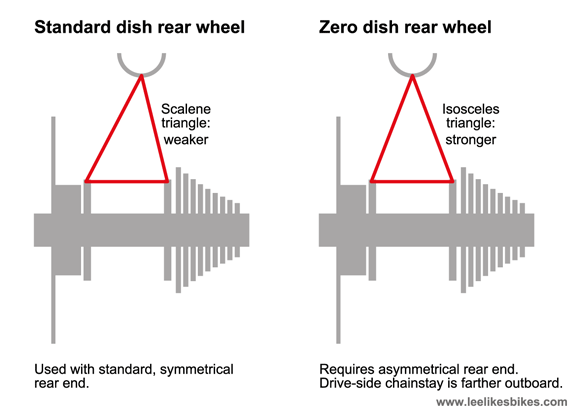Specialized asymmetrical rear end?

Hi Lee,
Love the book, it’s really helped me progress.
Since I visit your site and see you have the inside line with Specialized I was hoping you could answer the following question. The 06 and up Big Hits are said to have an asymmetrical rear triangle. I’ve noticed the wheel that came with the bike is not dished, but rather offset about 5mm away from the brake side (i.e. when I set the dishing tool against the hub locknut on the drive side first, the tip is then 5mm away from the hub locknut on the brake side. I’ve checked and the wheel is true.)
I have used aftermarket wheels that were dished and can’t say I noticed a difference. My 2.5 had no frame clearance issues. Should I offset this new wheel? What’s the purpose of the asymmetrical rear triangle?
Thanks! Matt
Hey Matt,
Specialized has been rocking the asymmetrical rear ends on BigHits, Demo 8s and later P.bikes. Compared with a standard-dish wheel, the stock rims are offset six millimeters to the brake side.
Advantages:
– You get a “zero-dish” rear wheel. In a standard wheel, the spokes are shorter on the drive side, which makes an uneven and relatively weak triangle. In a zero-dish wheel, the spokes are the same length on both sides. This creates an even, relatively stronger triangle. Isosceles, baby!
 Chicks dig info graphics! |
– The other benefit, according to Dr. Brandon Sloan at Specialized, is a better chain line. The cranks on bigger bikes tend to run wide, so moving the cogset outboard helps the chainline.
Considerations:
– You can ride a standard wheel in one of these bikes — they have plenty of tire clearance — but it won’t track directly behind your front wheel. I’ve done this out of temporary laziness; it’s funny how you can get used to anything.
– If you install a new wheel, definitely re-dish it six millimeters to the brake side. A dishing tool would be ideal. I’m such a Fred Flintsone mechanic, I just eyeball the rim with the seat tube.
Go forth and braaap!
— Lee

Comments are closed.